von Bernd Rabehl
Ex: http://www.hier-und-jetzt-magazine.de/

Gesellschaften, vor allem in der Formation ihrer erweiterten ökonomischen und technologischen Reproduktion vollziehen als kulturelle und historische Gemeinschaften nach Konrad Lorenz permanente ,,Pendelschläge“. Sie erleiden Mutationen und Pathologien und finden trotzdem, erfolgt nicht der Kollaps, zurück zu einer inneren, allerdings relativen Stabilität und Ordnung. Allen diesen unterschiedlichen Pendelbewegungen entsprechen ,,kulturelle Werte“. Sie tragen auf der ,,linken Seite“ den Anspruch der Individualität und ihrer freien Entfaltung. Auf der ,,rechten Seite“ fordern sie die soziale und kulturelle ,,Gesundheit“. Erst ihre Überspitzungen als soziale Gleichheit oder organische Ordnung führen zu den Prozessen der nationalsozialistischen oder kommunistischen Diktaturen. Deren militärische Zerschlagung oder innerer Zusammenbruch erreichten schließlich eine ausgewogene Mitte, etwa die westliche Demokratie, ehe das Pendel sich weiter bewegte und neue Instabilitäten schuf.
Historisch und persönlich sind Konrad Lorenz und die einzelnen Vertreter der ,,Kritischen Theorie“, etwa Erich Fromm, Theodor W. Adorno, Max Horkheimer, Herbert Marcuse, Franz Neumann u. a. durch diese Pendelbewegungen hindurchgegangen und waren Zeuge der sozialen Exzesse. Der Naturwissenschaftler und Verhaltensforscher, Konrad Lorenz, hatte allein durch seine Forschung und wissenschaftliche Tätigkeit Berührungen mit der rassistischen Weltanschauung des Nationalsozialismus, die ab 1933 eine allgegenwärtige staatliche Macht verkörperte. Sie trumpfte ähnlich wie ihr Gegenpart, der stalinistische Kommunismus, wissenschaftlich auf und schien eine vermeintliche Rassenhierarchie in Europa und der Welt naturwissenschaftlich zu begründen. Dieser wissenschaftliche Anspruch verdeckte allerdings nur oberflächlich die ideologische Zielsetzung. Biologen und Verhaltensforscher, die in Deutschland zu diesem Zeitpunkt arbeiteten, gerieten über ihre Arbeiten und Forschungsinstitute in die Nähe zur NS-Ideologie.
Diese Korrespondenzen waren objektiv gegeben, reichten heute jedoch nicht zum Vorwurf gegen Konrad Lorenz aus, mit dieser Diktatur kollaboriert zu haben. Solange eine langwierige Trennung von diesem „Rassismus“ über die wissenschaftliche Arbeit erfolgte und er selbst nicht Anteil hatte an der „sozialen Pathologie“ von rassistisch begründetem Massenmord, konnte ein derartiger Vorwurf nicht erhoben werden. Die Mitgliedschaft in der NSDAP, in einer fast 10 Millionen starken Transformations- und Massenpartei, die die Bedingung und Voraussetzung sozialer Kontrollen der Bürger in der Diktatur war, bot nicht das Material für eine Anklage, selbst wenn Lorenz sich dem damaligen politischen Jargon verschrieb. Kollaborationen bezogen sich nie auf einen Punkt oder einen Augenblick, sondern mußten über lange Zeitspannen beobachtet werden. Seine wissenschaftlichen Erfolge und Differenzierungen vor und nach 1945 begründeten den Freispruch. Dem immanenten Kreislauf eines sozialen Systems konnte er sowieso nicht entfliehen, es sei denn, daß seine Tätigkeit in der Wehrmacht nach 1942 als eine derartige Flucht angesehen wurde.
Die Vertreter der sogenannten ,,Frankfurter Schule“ verließen Deutschland kurz nach 1933, weil sie keinerlei Illusionen hatten, daß diese Diktatur eine aus den Fugen geratene Welt stabilisieren könnte. Im Gegenteil war diese Macht Auslöser und Faktor wachsender Kriegsgefahr. Sie gingen als deutsche Juden nach Frankreich und danach sehr schnell in die USA, denn die deutsche Unruhe schien Europa zu erfassen und mit Krieg und Gewalt zu überziehen. Hier in den USA blieben sie theoretisch mit der deutschen Kultur verbunden. Sie dachten weiterhin ,,deutsch“ und bemühten die Philosophien von Georg Wilhelm Friedrich Hegel und Karl Marx, aber vor allem von Arthur Schopenhauer und Friedrich Nietzsche, um diesen Umschlag sozialer Entwicklung in Diktatur und Haß zu verstehen. Allein weil ihre Fragen sich auf Aggression, Angst, Entfremdung, Psychologie und Moral bezogen, nahmen sie die Arbeiten von Sigmund Freud und C.G. Jung auf. Ein historischer Optimismus war ihnen so fremd wie die Illusionen über das historische Zeitmaß. Deshalb trennten sie sich vom Kommunismus und der politischen Arbeiterbewegung und standen dem amerikanischen Liberalismus und Konservatismus äußerst skeptisch gegenüber. Letztlich blieben sie deutsche Denker in einem fremden Land. Aber auch sie wurden von dem Pendelschlag gesellschaftlicher Mutationen erreicht. Die USA machten militärisch mobil gegen Japan und das Deutsche Reich und Herbert Marcuse und Franz Neumann stellten sich der Organisation of Strategic Services (OSS), dem Vorläufer der CIA, zur Verfügung.
Gefangen im Labyrinth
Sie bereiteten die militärische Besetzung Deutschlands und Europas vor, indem sie Untersuchungen über den sozialen und ideologischen Zustand der deutschen Gesellschaft vornahmen. Sie schrieben dabei gegen Pläne des amerikanischen Finanzministers Morgenthau an, Deutschland durch einen Bombenkrieg militärisch zu zerstören, politisch zu zerstückeln und zu deindustrialisieren. Nach ihrer Überzeugung hatte das ,,deutsche Volk“ nur bedingt Anteil an dem totalen Krieg gegen die Juden und andere europäische Völker. Ein hochindustrialisiertes Land mit seinen Facharbeitern, Ingenieuren, Wissenschaftlern und Spezialisten durfte weder zerschlagen, bestraft oder erniedrigt werden, sondern mußte zurückgeführt werden in eine westliche Friedensordnung. Die deutschen Kulturleistungen durften nicht ignoriert oder gar zerstört werden. Es wäre heute vollkommen abwegig, Marcuse oder Neumann die Mitarbeit in OSS und CIA vorzuwerfen, zumal sie im Sinne der deutschen Kultur dort positive Arbeit verrichteten. Die politischen Verstrickungen von Konrad Lorenz und den Repräsentanten der ,,Kritischen Theorie“ mit Diktatur oder Geheimdienst waren die Voraussetzungen und die Bedingungen ihrer wissenschaftlichen Arbeit. Niemand konnte dem Labyrinth gesellschaftlicher Zusammenhänge entfliehen. Bedeutsam blieb, inwieweit sie ,,Schuld“ auf sich nahmen und Anteil hatten an den sozialen Exzessen von Diktatur oder ,,Kriegsmaschine“. Es ist deshalb verständlich, daß Konrad Lorenz Herbert Marcuse verteidigte, dem von Seiten der französischen Studentenrevolte nach 1968 vorgeworfen wurde, CIA-Agent gewesen zu sein.
Bei allen methodischen und gedanklichen Unterschieden zwischen dem Naturwissenschaftler und Ethologen Konrad Lorenz und den Philosophen, Psychologen, Rechtswissenschaftlern und Soziologen der ,,Kritischen Theorie“ bestand eine erstaunliche Übereinstimmung in der Einschätzung der ,,sozialen Krankheiten“ der modernen Gesellschaft, deren Inkarnation die USA waren. Lorenz hatte hier vor 1933 studiert und besuchte nach 1948 immer wieder die nordamerikanischen Forschungseinrichtungen, Kongresse und Universitäten. Neumann und Marcuse wurden US-Bürger, andere wie Adorno und Horkheimer kehrten nach 1945 nach Frankfurt/Main zurück, wo sie das Institut für Sozialforschung neu einrichteten. Alle kannten sie die Größe und die Absurditäten dieser Gesellschaft. Was hier passierte, würde sehr bald den ,,Rest“ der Welt erreichen.
Für Lorenz und die kritischen Kritiker waren die USA Ausdruck sozialer Pathologien oder Neurosen, die die soziale Stabilität auflösten und in ein Extrem von ,,Wahnsinn“ und Brutalität trieben. Nach Lorenz wurden hier ökologische Katastrophen vorbereitet und entstanden Menschenkrüppel, die durch ihre Gefühlskälte, durch ihren Konsumtrieb, Arbeitshetze und die wachsende Gleichgültigkeit parasitäre und asoziale Verhaltensweisen vorbereiteten, die jede Lebensgemeinschaft oder Soziität zerfetzen mußten. Die menschliche Gattung bewegte sich in die Selbstzerstörung durch Atomkrieg oder durch ökologische Katastrophen.
Soziale Pathologien
Für die ,,Frankfurter“ waren die USA Beleg für eine ,,negative Dialektik“. Nicht der technologische und soziale Fortschritt wurde durch die gesellschaftliche Entwicklung vorbereitet, sondern der allgemeine Niedergang, Dekadenz und Zerfall zeigten sich in dieser entwickelten Gesellschaft des modernen Kapitalismus. Die NS-Diktatur, der Stalinismus oder der Realsozialismus waren jeweils nur Durchgangspunkte zu einem modernen Totalitarismus, der in den USA seine ,,weiche“ Heimstatt gefunden hatte. Die Auflösung der Klassen und die Formierung von Massen als Objekte politischer oder marktmäßiger Inszenierungen schufen einen konvertiblen Massenmenschen, der mit seiner ,,Persönlichkeit“ den Charakter verloren hatte und der durch die unbewußten Ängste und Aggressionen beliebig manipulierbar war. Er war ein Bündel aus Haß und Wut, der den Fremden als permanente Bedrohung sah und deshalb empfänglich war für rassistische Ideologien oder für eine autoritäre Ordnung. Der Nationalsozialismus feierte in den USA als ,,alltäglicher Faschismus“ seine subtile Auferstehung.
Der Mensch wurde zu einem psychopathologischen Reaktionswesen erklärt, das jeweils auf Reize, Farben, Töne, Versprechungen, Wünsche und Bilder reagierte und von außen geformt wurde und keinerlei Gewissen oder Verantwortung mehr besaß. Der Tod war ihm so egal wie die Liebe. Der Tod wurde verdrängt oder zum Medienspiel verdünnt und die Liebe auf pure Sexualität, Besitz und Macht beschränkt. Der ,,eindimensionale“ Mensch hatte keinerlei Moral und war ein Aggregat aus Reizen und Emotionen, eine Freß-, Sauf- und Konsummaschine, ein Machwerk aus Funktionen und Frustrationen, ein außermenschlicher Mensch, der von Diktatoren oder Manipulatoren beliebig einsetzbar war. Soziale Widersprüche fanden ihren Endpunkt. Das Ende der Geschichte war erreicht. Die Menschen würden sich selbst zerstören und ihre organischen Systeme als Familien, Staaten und Gesellschaften austilgen. Der Planet würde die Gattung Mensch durch die Machenschaften der Menschen verlieren.
Konrad Lorenz würde die Aussagen dieser Kritiker verstehen, aber ihre Begründungen nicht nachvollziehen können, waren sie doch philosophisch, religiös und moralisch angelegt. Umgekehrt würden diese Philosophen Zweifel anmelden, ob soziale Verhaltensweisen, die bei Tieren beobachtet wurden, auf die menschliche Gattung übertragbar waren und ob über Mutationen und Selektionen neue Instinkte beim Menschen entstanden, die alle Kulturleistungen überdeckten bzw. diese umformten. Für diese kritischen Philosophen und Soziologen gab es eine Barriere zwischen Mensch und Tier. Der Mensch als ,,soziales Tier“ distanzierte sich über Sprache, Moral, Religion, Gesellschaft von den Tieren und verlor weitgehend die Instinkte bzw. ersetzte sie durch Denken, Arbeit, Arbeitsteilung, Kultur, Erziehung, Institutionen, Technologie, Maschinen, Religion und Ideologie. Umgekehrt würde Lorenz diese Grenze nicht akzeptieren und deutlich machen, daß sie aus ideologischen und religiösen Gründen gezogen wurde, um das ,,Tier“ im Menschen nicht zu benennen, den ,,Urmenschen“, der aus dem Tierreich gekommen war und viele seine Verhaltensweisen und Instinkte in die entstehenden Gesellschaften hinübergerettet hatte.
Soziales Tier oder „Black Box“?
Konrad Lorenz wußte von den unterschiedlichen Vereinnahmungen der Naturwissenschaften und der Ethologie durch die totalitären Ideologien, bei denen der Marxisrnus-Leninismus viel konsequenter auftrat als der oberflächlich „improvisierte“ Rassismus im Nationalsozialismus. Lorenz war deshalb bestrebt, die Grenzen und Übergänge von Naturwissenschaft, Soziologie und Psychologie zu benennen. Die Denker der Frankfurter Schule würden eher der Logik Hegels folgen und den Widerspruch zwischen Natur- und Sozialwissenschaften herausstellen. Beide Wissenschaftsformen hatten unterschiedliche Objekte ihrer Forschung zur Grundlage und ließen sich nur bedingt übertragen und diese Übersetzung benötigte eine grundlegende Reflektion, um banale und gefährliche Analogieschlüsse zu vermeiden. Bei Lorenz dominierte das Interesse, die Konditionierung von Verhaltensweisen bei Tieren und Menschen, die Instinktbildung und die fortlaufende Pathologisierung bei schnellen Veränderungen der äußeren Bedingungen nachzuweisen. Bei den Frankfurtern interessierten philosophische Fragestellungen, die Trieb und Aggressionslehre der Psychoanalyse, die Fetischisierung von Markt und Marketing.
Die amerikanische Verhaltenswissenschaft stand den Forschungsansätzen der Ethologie von Lorenz konträr entgegen, denn sie ignorierte die natürliche, verhaltensmäßige und soziale Vorgeschichte und Tradition des Menschen und behauptete, daß er als eine ,,black box“ zu behandeln sei, eine ,,tabula rasa“ darstellte, und daß nur interessant war, was er unmittelbar aussagte, vorstellte und welchen Reizen er folgte. Eine derartige ,,Freisetzung“ des Menschen von allen natürlichen und sozialen Bindungen entsprach der amerikanischen Ideologie von Freiheit, Raum und Bewegung und diente dem amerikanischen Traum, alles zu erreichen. Eine derartige Sichtweise akzeptierte, daß der ,,traditionslose“ Mensch Objekt der Manipulationen, Indoktrinationen und Inszenierungen wird.
1 Konrad Lorenz: Die acht Todsünden der zivilisierten Menschheit, München 1973, S. 819, S. 27, S. 33 ff.; Konrad Lorenz in: Enceklopaedia Britannica, 1994 – 2001; Herbert Marcuse: Antidemokratische Volksbewegungen, in. Ders.: Nachgelassene Schriften: Das Schicksal der bürgerlichen Demokratie, Peter Erwin Jansen (Hg.), Lüneburg 1999, s.29 ff;
Ders. Der eindimensionale Mensch, Studien zur Ideologie der fortgeschrittenen Industriegesellschaft, Neuwied 1985, 5.
15,3.18; Alfons SölIner. Zur Archäologie der Demokratie in Deutschland – eine Forschungshypothese zur theoretischen Praxis der kritischen Theorie im amerikanischen Geheimdienst‘ Frankfurt 1987, S. 7ff.;


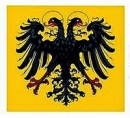

 del.icio.us
del.icio.us
 Digg
Digg
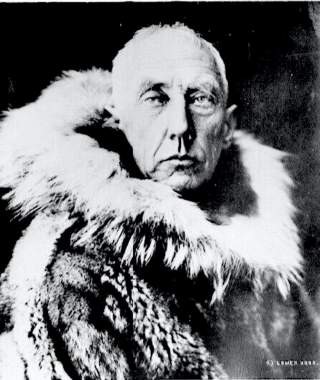 The shore party consisted of 97 dogs and eight humans, all Norwegian: Olav Bjaaland, Helmer Hanssen, Sverre Hassel, Oscar Wisting, Jørgen Stubberud, Hjalmar Johansen, Kristian Prestrud, and Roald Amundsen. Like Scott, they built a hut, but, unlike Scott, when the snow and drift started to cover it, Amundsen’s party allowed it to be buried, and expanded their living quarters by excavating a network caverns in the ice, where they set up their kennel and their workshops. This not only afforded them more space, but also insulated them from the elements.
The shore party consisted of 97 dogs and eight humans, all Norwegian: Olav Bjaaland, Helmer Hanssen, Sverre Hassel, Oscar Wisting, Jørgen Stubberud, Hjalmar Johansen, Kristian Prestrud, and Roald Amundsen. Like Scott, they built a hut, but, unlike Scott, when the snow and drift started to cover it, Amundsen’s party allowed it to be buried, and expanded their living quarters by excavating a network caverns in the ice, where they set up their kennel and their workshops. This not only afforded them more space, but also insulated them from the elements.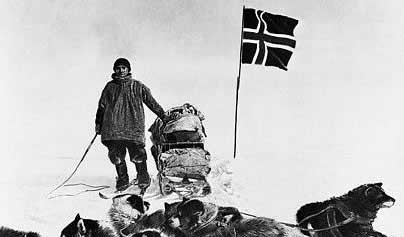 This takes us to the diet. Scott’s understanding of a polar explorer’s nutritional requirements was the best that could be expected from the Edwardian era, so he cannot be blamed for having had inadequate provisions. Indeed, having learned from his failed bid for the Pole in 1902 and from
This takes us to the diet. Scott’s understanding of a polar explorer’s nutritional requirements was the best that could be expected from the Edwardian era, so he cannot be blamed for having had inadequate provisions. Indeed, having learned from his failed bid for the Pole in 1902 and from 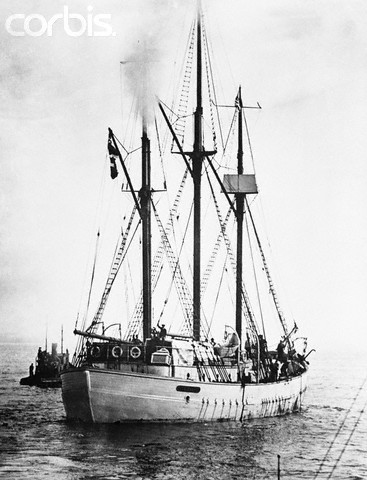 Amundsen’s original ambition had been to conquer the North Pole. For most of his life, he tells us, he had been fascinated by the far North. That he turned South owed to his being beaten to the North Pole by the American explorers Fredrick Cook (in 1908) and Robert Peary (in 1909), who made independent claims. Therefore, upon reaching the South Pole, Amundsen experienced mixed feelings: he says that it did not feel to him like the accomplishment of his life’s ambition. All the same, aware of the controversies surrounding Cook’s and Peary’s polar claims, he determined to make absolutely certain that he had indeed reached the geographical South Pole, and spent several days taking measurements with a variety of instruments within a chosen radius. He named his South Pole station Polheim. There he left a small tent with a letter for Scott to deliver to the King Haakon VII of Norway, as proof and testimony of his accomplishment in the event he failed to return to base safely.
Amundsen’s original ambition had been to conquer the North Pole. For most of his life, he tells us, he had been fascinated by the far North. That he turned South owed to his being beaten to the North Pole by the American explorers Fredrick Cook (in 1908) and Robert Peary (in 1909), who made independent claims. Therefore, upon reaching the South Pole, Amundsen experienced mixed feelings: he says that it did not feel to him like the accomplishment of his life’s ambition. All the same, aware of the controversies surrounding Cook’s and Peary’s polar claims, he determined to make absolutely certain that he had indeed reached the geographical South Pole, and spent several days taking measurements with a variety of instruments within a chosen radius. He named his South Pole station Polheim. There he left a small tent with a letter for Scott to deliver to the King Haakon VII of Norway, as proof and testimony of his accomplishment in the event he failed to return to base safely. WikiLeaks lässt in seinen Bemühungen, Licht in das Dunkel von Verschwörungen, Korruption und Vertuschungen zu bringen, nicht nach und erschüttert damit weiterhin die politische Welt. Aus den jüngsten, von WikiLeaks veröffentlichten amerikanischen Botschaftsberichten geht hervor, dass die USA als treibende Kraft hinter den Kulissen daran beteiligt sind, europäischen Ländern gentechnisch veränderte Organismen (sogenannte »GMO«) aufzuzwingen. Sollten sie sich weigern, hätten sie mit gesalzenen Strafmaßnahmen zu rechnen.
WikiLeaks lässt in seinen Bemühungen, Licht in das Dunkel von Verschwörungen, Korruption und Vertuschungen zu bringen, nicht nach und erschüttert damit weiterhin die politische Welt. Aus den jüngsten, von WikiLeaks veröffentlichten amerikanischen Botschaftsberichten geht hervor, dass die USA als treibende Kraft hinter den Kulissen daran beteiligt sind, europäischen Ländern gentechnisch veränderte Organismen (sogenannte »GMO«) aufzuzwingen. Sollten sie sich weigern, hätten sie mit gesalzenen Strafmaßnahmen zu rechnen.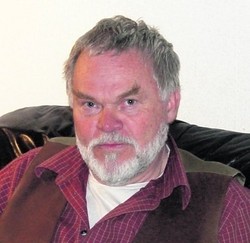
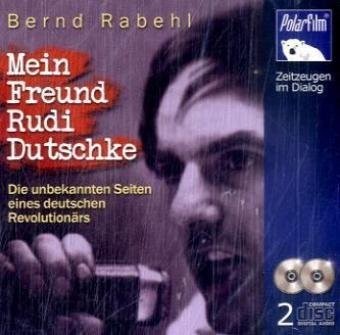 A: United States even today have the right to intervene in the internal affairs of every European Union member state, and especially in Germany. It is not necessary to use military force for this. How was that achieved? After 1945, German elite went through the process of re-education. US was also exerting influence over the policies of German syndicates and political parties.
A: United States even today have the right to intervene in the internal affairs of every European Union member state, and especially in Germany. It is not necessary to use military force for this. How was that achieved? After 1945, German elite went through the process of re-education. US was also exerting influence over the policies of German syndicates and political parties. A: I was shocked when I saw how quickly people can discard their ideals, literally overnight, and step in the roles of “important politicians”. I’m horrified by the barefaced hatred of these people towards their own German nation. Tossed in the garbage bin are the great achievements of the German workers’ movement, German conservatism and liberalism. I, on the other hand, believe the European culture can only exist as the sum of different, national cultures, and not some amorphous mass drowned in the common cauldron as a unified “Coca-Cola culture”.
A: I was shocked when I saw how quickly people can discard their ideals, literally overnight, and step in the roles of “important politicians”. I’m horrified by the barefaced hatred of these people towards their own German nation. Tossed in the garbage bin are the great achievements of the German workers’ movement, German conservatism and liberalism. I, on the other hand, believe the European culture can only exist as the sum of different, national cultures, and not some amorphous mass drowned in the common cauldron as a unified “Coca-Cola culture”.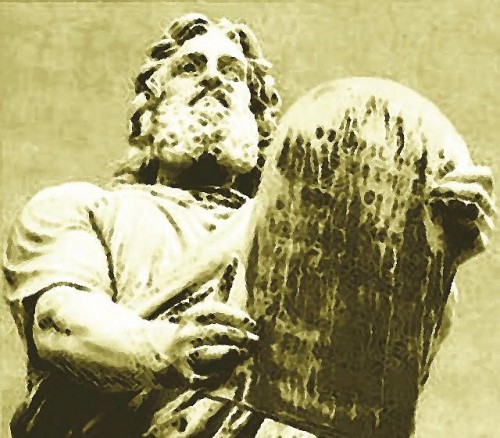

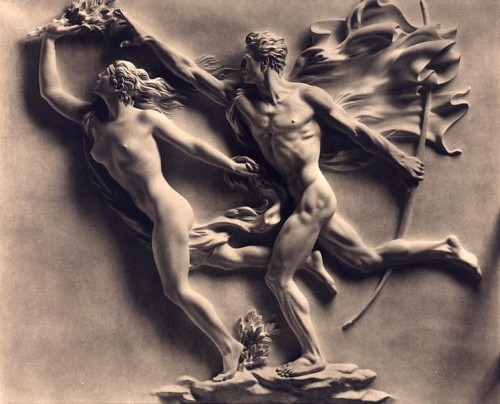
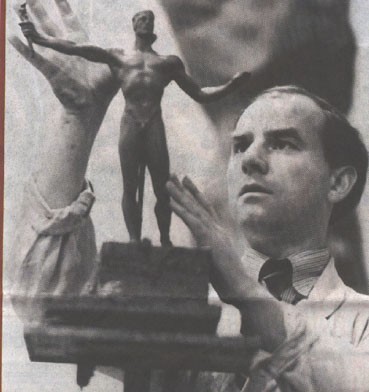 All of Breker’s pieces have precedents in the ancient world, but this has to be understood in an active rather than a passive or re-directed way. If we think of the Hellenism which Alexander’s all-conquering armies inspired deep into Asia Minor (and beyond), then pieces like the Laocoön at the Vatican or the full-nude portrait of Demetrius the First of Syria, whose modelling recalls Lysippus’ handling, are definite precursors. (This latter piece is in the National Museum in Rome.) Yet Breker’s work is quite varied, in that it contains archaic, semi-brutalist, unshorn, martial relief and post-Cycladic material. There is also the resolution of an inner tension leading to a Stoic calm, or a heroic and semi-religious rest, that recalls the Mannerist art of the sixteenth century. Certain commentators, desperate for some sort of affiliation to modernism in order to “save” Breker, speak loosely of Expressionist sub-plots. This is quite clearly going too far — but it does draw attention to one thing . . . namely, that many of these sculptures indicate an achievement of power, a rest or beatitude after turmoil. They are indicative of Hemingway’s definition of athletic beauty — that is to say, grace under pressure or a form of same.
All of Breker’s pieces have precedents in the ancient world, but this has to be understood in an active rather than a passive or re-directed way. If we think of the Hellenism which Alexander’s all-conquering armies inspired deep into Asia Minor (and beyond), then pieces like the Laocoön at the Vatican or the full-nude portrait of Demetrius the First of Syria, whose modelling recalls Lysippus’ handling, are definite precursors. (This latter piece is in the National Museum in Rome.) Yet Breker’s work is quite varied, in that it contains archaic, semi-brutalist, unshorn, martial relief and post-Cycladic material. There is also the resolution of an inner tension leading to a Stoic calm, or a heroic and semi-religious rest, that recalls the Mannerist art of the sixteenth century. Certain commentators, desperate for some sort of affiliation to modernism in order to “save” Breker, speak loosely of Expressionist sub-plots. This is quite clearly going too far — but it does draw attention to one thing . . . namely, that many of these sculptures indicate an achievement of power, a rest or beatitude after turmoil. They are indicative of Hemingway’s definition of athletic beauty — that is to say, grace under pressure or a form of same. Another interesting exchange between Muller and Breker in this interview concerns the Shoah. (It is important to realise that this highly-charged chat is not an exercise in reminiscence. It concerns the morality of revolutionary events in Europe and their aftermath.) By any stretch, Breker declares himself to be a believer and that the criminal death through a priori malice of anyone, particularly due to their ethnicity, is wrong. At first sight this appears to be an unremarkable statement. A bland summation would infer that the neo-classicist was a believer in Christian ethics, et cetera. . . . Yet, viewed again through a different premise, something much more revolutionary emerges. Breker declares himself to be a “believer” (that is to say, an “exterminationist” to use the vocabulary of Alexander Baron); yet even to affirm this is to admit the possibility of negation or revision (itself a criminal offense in the new Germany). For the most part contemporary opinion mongers don’t declare that they believe in Global warming, the moon shot, or the link between HIV and AIDS — they merely affirm that no “sane” person doubts it.
Another interesting exchange between Muller and Breker in this interview concerns the Shoah. (It is important to realise that this highly-charged chat is not an exercise in reminiscence. It concerns the morality of revolutionary events in Europe and their aftermath.) By any stretch, Breker declares himself to be a believer and that the criminal death through a priori malice of anyone, particularly due to their ethnicity, is wrong. At first sight this appears to be an unremarkable statement. A bland summation would infer that the neo-classicist was a believer in Christian ethics, et cetera. . . . Yet, viewed again through a different premise, something much more revolutionary emerges. Breker declares himself to be a “believer” (that is to say, an “exterminationist” to use the vocabulary of Alexander Baron); yet even to affirm this is to admit the possibility of negation or revision (itself a criminal offense in the new Germany). For the most part contemporary opinion mongers don’t declare that they believe in Global warming, the moon shot, or the link between HIV and AIDS — they merely affirm that no “sane” person doubts it.

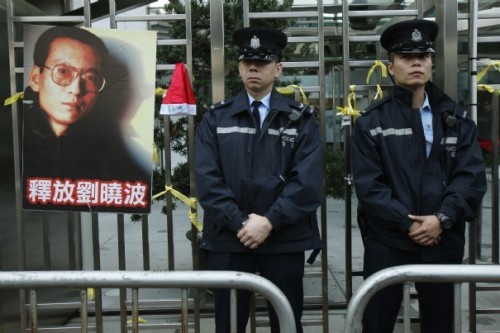
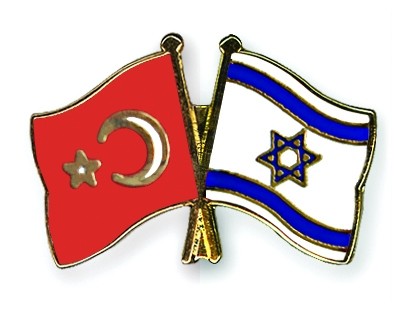 Turkey's foreign minister says he wants to repair ties with Israel, damaged
Turkey's foreign minister says he wants to repair ties with Israel, damaged

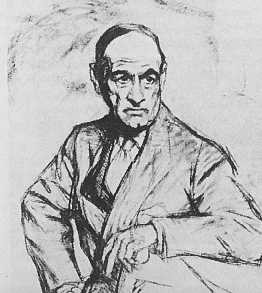 Sans doute le grand romancier trouva-t-il aussi dans le livre du philosophe, comme le remarque José Luis Goyenna dans son intéressante (quoique pleine de fautes) préface, en plus d'images étonnantes bien propres à enthousiasmer l'écrivain, une authentique philosophie de la liberté comme accomplissement métaphysique du moi qui, à la différence de celle de Sartre qualifiée par l'auteur d'Ultramarine de «pensée de seconde main» (2), ne se dépêcherait pas bien vite de déposer aux pieds de l'idole le fardeau trop pesant, enchaînant ainsi la liberté à la seule discipline stupide des masses. Tout lecteur de La révolte des masses aime je crois, en tout premier lieu, l'écriture de ce livre érudit, pressé, menaçant, parfois prodigieusement lucide et même, osons ce mot tombé dans l'ornière journalistique, prophétique.
Sans doute le grand romancier trouva-t-il aussi dans le livre du philosophe, comme le remarque José Luis Goyenna dans son intéressante (quoique pleine de fautes) préface, en plus d'images étonnantes bien propres à enthousiasmer l'écrivain, une authentique philosophie de la liberté comme accomplissement métaphysique du moi qui, à la différence de celle de Sartre qualifiée par l'auteur d'Ultramarine de «pensée de seconde main» (2), ne se dépêcherait pas bien vite de déposer aux pieds de l'idole le fardeau trop pesant, enchaînant ainsi la liberté à la seule discipline stupide des masses. Tout lecteur de La révolte des masses aime je crois, en tout premier lieu, l'écriture de ce livre érudit, pressé, menaçant, parfois prodigieusement lucide et même, osons ce mot tombé dans l'ornière journalistique, prophétique.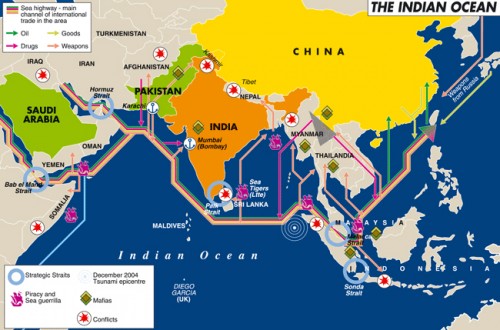
 It is almost too perfectly-scripted to be true. A discontented 22 -year old US Army soldier on duty in Baghdad, Bradley Manning, a low-grade US Army intelligence analyst, described as a loner, a gay in the military, a disgruntled “computer geek,” sifts through classified information at Forward Operating Base Hammer. He decides to secretly download US State Department email communications from the entire world over a period of eight months for hours a day, onto his blank CDs while pretending to be listening to Lady Gaga. In addition to diplomatic cables, Manning is believed to have provided WikiLeaks with helicopter gun camera video of an errant US attack in Baghdad on unarmed journalists, and with war logs from Iraq and Afghanistan.
It is almost too perfectly-scripted to be true. A discontented 22 -year old US Army soldier on duty in Baghdad, Bradley Manning, a low-grade US Army intelligence analyst, described as a loner, a gay in the military, a disgruntled “computer geek,” sifts through classified information at Forward Operating Base Hammer. He decides to secretly download US State Department email communications from the entire world over a period of eight months for hours a day, onto his blank CDs while pretending to be listening to Lady Gaga. In addition to diplomatic cables, Manning is believed to have provided WikiLeaks with helicopter gun camera video of an errant US attack in Baghdad on unarmed journalists, and with war logs from Iraq and Afghanistan.
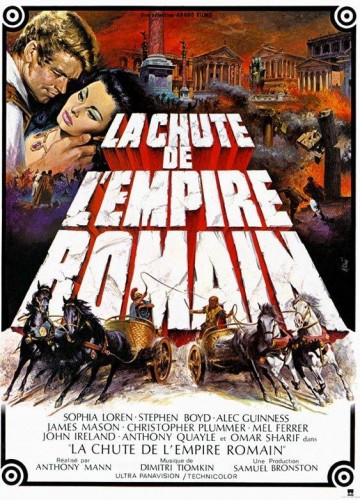






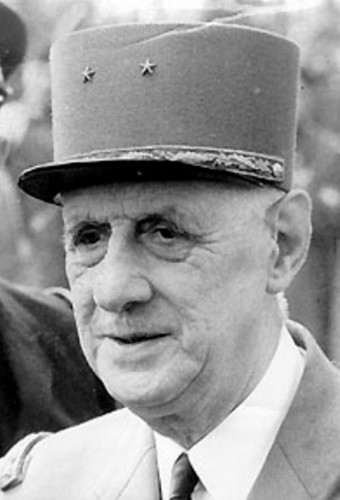 Dominique de Roux s'était fait une certaine idée de de Gaulle comme de Gaulle (première phrase de ses Mémoires) s'était toujours fait une certaine idée de la France. On était en 1967, la subversion ne s'affichait pas encore au grand jour, mais déjà l'on sentait sourdre la révolte souterraine, la faille entre les générations aller s'élargissant. L'Occident à deux têtes (libéral-capitaliste à l'Ouest, marxiste-léniniste à l'Est) paissait paisiblement, inconscient d'être bientôt débordé sur sa gauche par ses éléments bourgeois les plus nihilistes et, on ne s'en apercevra que plus tard, les plus réactionnaires. Dominique de Roux lui aussi cherchait l'alternative. La littérature jusqu'ici n'avait été qu'un appui-feu dans la lutte idéologique. Qu'à cela ne tienne, de Roux inventerait la littérature d'assaut, porteuse de sa propre justification révolutionnaire, la dé-poétisation du style en une mécanique dialectique offensive. Le sens plus que le plaisir des sens, la parole vivante plutôt que la lettre morte. De Roux, qui résumait crise du politique et crise de la fiction en une seule et même crise de la politique-fiction, avait lu en de Gaulle l'homme prédestiné par qui enfin le tragique allait resurgir sur le devant de la scène historique après vingt ans d'éviction. Le cheminement de de Gaulle homme d'Etat tel qu'il était retracé dans ses Mémoires, n'indiquait-il pas «l'identification tragique de l'action rêvée et du rêve en action»? (1) .
Dominique de Roux s'était fait une certaine idée de de Gaulle comme de Gaulle (première phrase de ses Mémoires) s'était toujours fait une certaine idée de la France. On était en 1967, la subversion ne s'affichait pas encore au grand jour, mais déjà l'on sentait sourdre la révolte souterraine, la faille entre les générations aller s'élargissant. L'Occident à deux têtes (libéral-capitaliste à l'Ouest, marxiste-léniniste à l'Est) paissait paisiblement, inconscient d'être bientôt débordé sur sa gauche par ses éléments bourgeois les plus nihilistes et, on ne s'en apercevra que plus tard, les plus réactionnaires. Dominique de Roux lui aussi cherchait l'alternative. La littérature jusqu'ici n'avait été qu'un appui-feu dans la lutte idéologique. Qu'à cela ne tienne, de Roux inventerait la littérature d'assaut, porteuse de sa propre justification révolutionnaire, la dé-poétisation du style en une mécanique dialectique offensive. Le sens plus que le plaisir des sens, la parole vivante plutôt que la lettre morte. De Roux, qui résumait crise du politique et crise de la fiction en une seule et même crise de la politique-fiction, avait lu en de Gaulle l'homme prédestiné par qui enfin le tragique allait resurgir sur le devant de la scène historique après vingt ans d'éviction. Le cheminement de de Gaulle homme d'Etat tel qu'il était retracé dans ses Mémoires, n'indiquait-il pas «l'identification tragique de l'action rêvée et du rêve en action»? (1) .
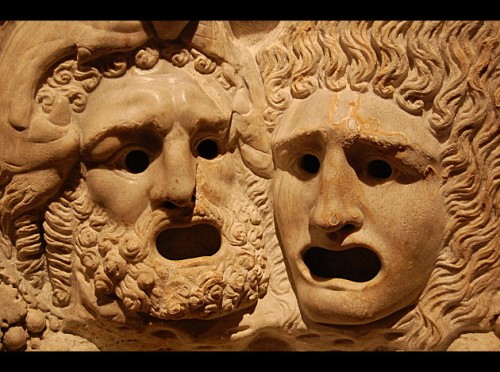
.jpg)

 Alternative Nabucco. Während der EU-Kommissar nach außen darauf besteht, dem South-Stream-Projekt eine faire Chance einzuräumen, arbeitet er de facto an dessen Sabotage, zugunsten von Nabucco. Holzner wird in der Presse mit den Worten zitiert: »Europäische Vertreter hatten Einwände dagegen, dass Bulgarien durch den Vertrag mit Russland zur vollständigen und ungehinderten Durchleitung russischen Gases über das eigene Staatsgebiet verpflichtet war […] Für uns liegt die Priorität bei Nabucco, weil damit die Quellen für die Gasversorgung leichter diversifiziert werden können.«
Alternative Nabucco. Während der EU-Kommissar nach außen darauf besteht, dem South-Stream-Projekt eine faire Chance einzuräumen, arbeitet er de facto an dessen Sabotage, zugunsten von Nabucco. Holzner wird in der Presse mit den Worten zitiert: »Europäische Vertreter hatten Einwände dagegen, dass Bulgarien durch den Vertrag mit Russland zur vollständigen und ungehinderten Durchleitung russischen Gases über das eigene Staatsgebiet verpflichtet war […] Für uns liegt die Priorität bei Nabucco, weil damit die Quellen für die Gasversorgung leichter diversifiziert werden können.«